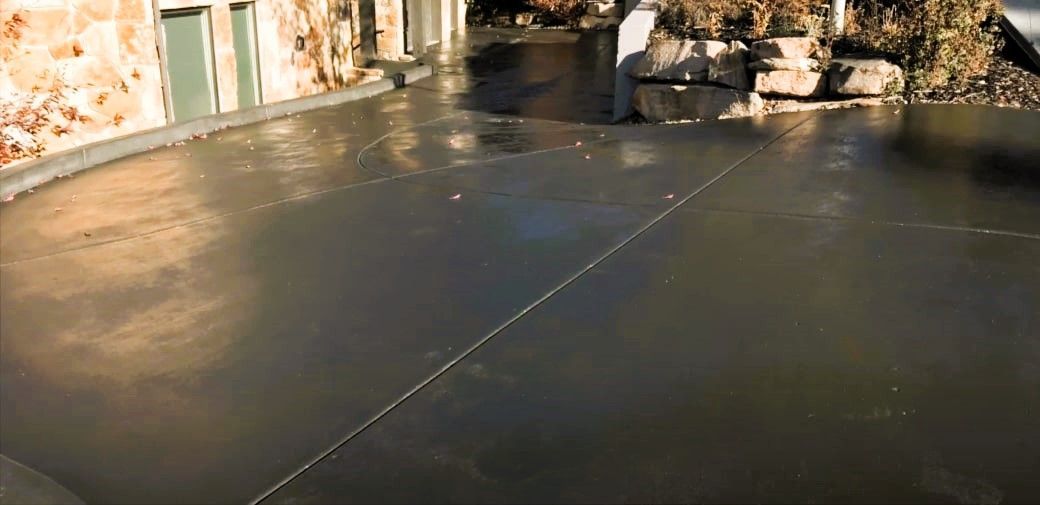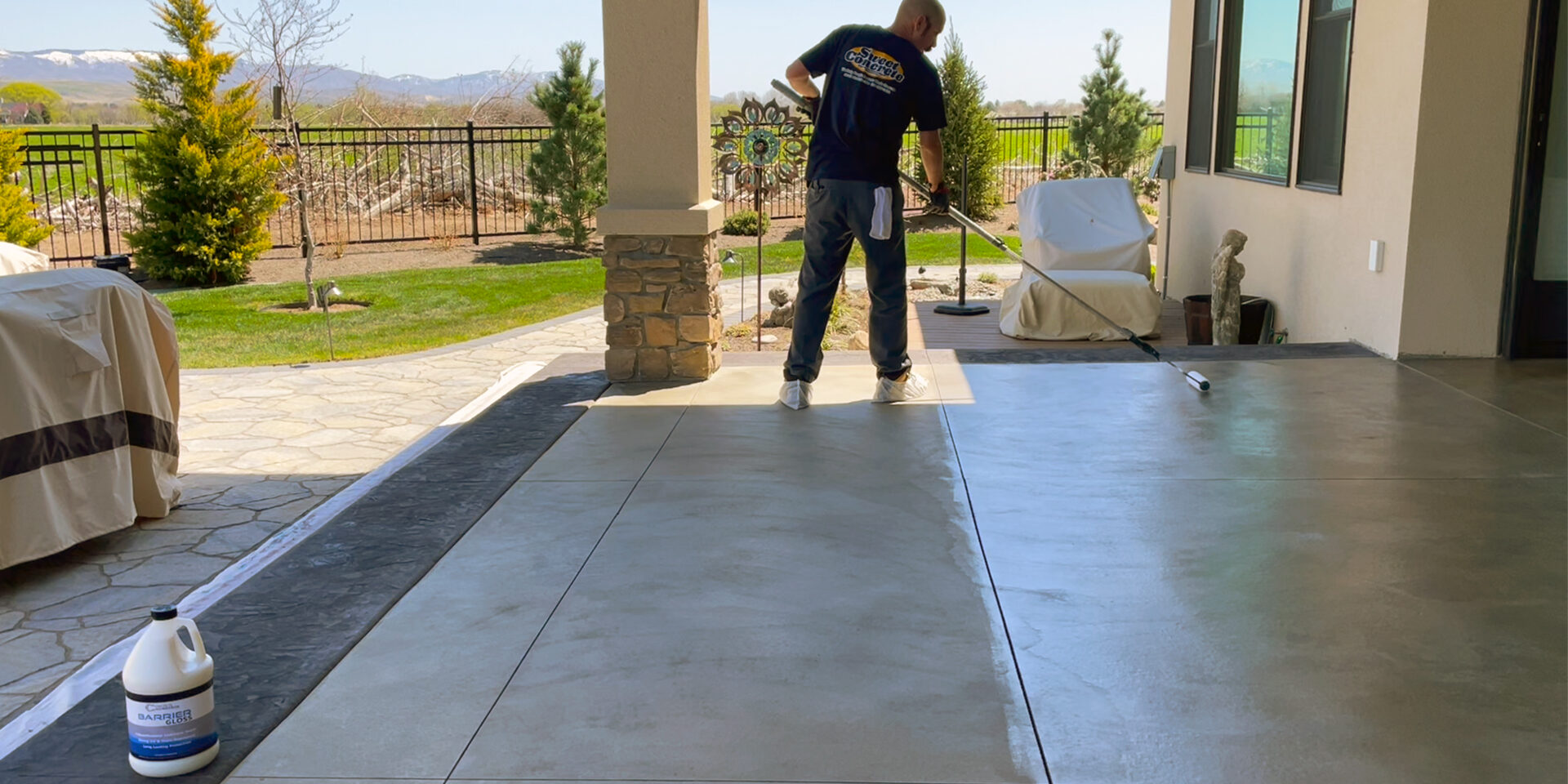All About Stained Concrete: A Comprehensive Overview to Its Advantages and Applications
Stained concrete has become a preferred selection for both domestic and industrial areas. Its capacity to combine aesthetic appeal with practicality makes it an appealing option. Various staining techniques provide a variety of colors and finishes, permitting customization. However, the advantages expand past look. Comprehending its applications and maintenance requirements is crucial for anybody considering this flexible material. The nuances of stained concrete invite further exploration.
What Is Stained Concrete?

Staining can be applied to various surface areas, including floors, driveways, and patios, making it a versatile option for both interior and exterior rooms. The therapy can achieve a series of looks, from earthy tones to strong, modern-day layouts. Unlike paint, stained concrete preserves its look with time, as it becomes an essential component of the concrete itself. Generally, stained concrete serves as an effective method for transforming ordinary concrete right into aesthetically striking surfaces.
Benefits of Stained Concrete
Stained concrete offers substantial advantages, specifically in aesthetic allure and durability - stained concrete contractors. Its vivid colors and distinct patterns enhance the aesthetic charm of any kind of room, making it a prominent choice for both household and industrial applications. Additionally, the long life of stained concrete assurances that it continues to be a sensible financial investment gradually, withstanding wear and tear
Visual Allure
One of one of the most compelling benefits of utilizing stained concrete is its remarkable aesthetic allure. Stained concrete deals an unique and flexible look that can match numerous layout styles, from contemporary to rustic. The mixture of dynamic shades and detailed patterns allows home owners and designers to create personalized surfaces that can enhance the general atmosphere of a space. Unlike standard floor covering alternatives, stained concrete can resemble the appearance of natural rock or polished marble, supplying an upscale appearance without the associated expenses. In addition, the glossy surface alternatives can reflect light, additional brightening insides. This flexibility makes stained concrete a popular selection for both domestic and commercial applications, where visual effect is critical.
Durability and Longevity
The outstanding visual high qualities of stained concrete are complemented by its amazing sturdiness and long life - stained concrete company. Stained concrete surface areas are resistant to put on and tear, making them ideal for high-traffic locations both indoors and outdoors. Their robust nature indicates they can endure severe climate condition, consisting of extreme temperature levels, rainfall, and UV exposure, without significant degradation. On top of that, stained concrete requires minimal upkeep contrasted to various other flooring choices, as it does not need frequent sealing or refinishing. This durability not just reduces substitute prices yet likewise contributes to a sustainable structure approach. Generally, stained concrete offers an enduring option that integrates aesthetic charm with sensible advantages, ensuring its value with time
Various Sorts Of Staining Techniques
Different discoloration methods can considerably impact the aesthetic qualities of concrete surface areas. The 3 key techniques include acid staining, which responds chemically with the concrete, water-based staining, which offers a more comprehensive series of colors, and overlay discoloration options that give a fresh surface area. Each method has distinct characteristics and applications that cater to various layout preferences and task demands.
Acid Staining Method
How can homeowners change ordinary concrete surfaces right into visually striking functions? One reliable technique is acid discoloration, a popular technique that improves the all-natural charm of concrete. This process involves using a remedy of water, hydrochloric acid, and metal salts to the concrete surface area. As the acid reacts with the lime present in the concrete, it develops abundant, variegated colors that appear like marble or stone. Acid staining is known for its resilience and resistance to fading, making it a long-lasting option for both interior and outside applications. It is essential to note that the results can differ based on the original concrete color and structure. Proper application and sealing are vital for accomplishing the preferred visual and long life
Water-Based Discoloration Method
A preferred option to acid staining, the water-based staining technique provides house owners a functional way to improve Get More Info concrete surface areas. This technique makes use of water-soluble dyes and pigments, enabling for a variety of colors and finishes. Unlike acid discolorations, water-based discolorations can be related to unsealed concrete and provide a simpler clean-up procedure. The results can accomplish a more uniform look and can be layered to develop distinct results. In addition, water-based discolorations are usually less poisonous and emit fewer unstable organic compounds (VOCs), making them more eco-friendly. Home owners might value the ability to tailor their concrete surface areas with different shades, allowing for imaginative expression while keeping durability and durability in their flooring options.
Overlay Staining Options
Countless overlay discoloration choices exist for property owners looking to invigorate their concrete surface areas. One preferred selection is acid staining, which reacts chemically with the concrete to generate rich, variegated shades. An additional option is water-based discoloration, using a broader color scheme and easier application. In addition, concrete overlays can be integrated with patterns for intricate styles, enhancing aesthetic appeals. For an extra textured surface, home owners might take into consideration utilizing stamped overlays that mimic natural products navigate to these guys like rock or floor tile. Each technique gives one-of-a-kind advantages, from resilience to modification, permitting a tailored touch. Inevitably, the option of overlay discoloration depends upon the preferred look and the problem of the existing concrete, making certain a freshened and attractive surface.
Applications of Stained Concrete
Stained concrete offers a flexible service for various applications, enhancing both aesthetic appeal and functionality. This material is commonly utilized in household, business, and commercial setups, making it a preferred selection amongst engineers and developers. In homes, stained concrete can function as elegant flooring or outdoor patios, giving a sophisticated appearance while continuing to be durable.
In commercial areas, such as stores and dining establishments, stained concrete adds to a modern-day atmosphere and can hold up against heavy foot web traffic. In addition, stained concrete is progressively made use of in public areas like parks and sidewalks, where its capacity to mimic natural stone or various other products adds aesthetic passion.
In addition, stained concrete is ideal for swimming pool decks and driveways, supplying a slip-resistant surface that is easy to maintain. Generally, the versatility of stained concrete makes it suitable for various settings, satisfying varied tastes and needs.
Maintenance and Treatment for Stained Concrete
Appropriate maintenance ensures the durability and elegance of stained concrete surfaces. Routine cleaning is essential; using a moderate cleaning agent and water with a soft-bristle brush assists get rid of dust and crud without damaging the surface. It is suggested to prevent harsh chemicals that can remove the tarnish or sealer.
Securing stained concrete is important for defense versus dampness, stains, and use. A high-grade sealer you can try here should be reapplied each to three years, relying on the traffic and exposure the surface area endures. Furthermore, addressing spills immediately will avoid discoloration and discoloration.

Cost Factors To Consider for Stained Concrete Projects
When preparing a tarnished concrete project, budget plan factors to consider play an essential function in determining the overall expense. The expenditures related to stained concrete can vary substantially based upon several elements. The dimension of the location to be stained directly influences product and labor costs. Bigger rooms will naturally require more sources. Second, the type of tarnish selected-- acid-based or water-based-- can impact prices, with acid spots typically being extra expensive. Furthermore, the intricacy of the design, including patterns or multiple colors, can enhance labor prices. Preparation job, such as cleansing and grinding the concrete surface area, contributes to the initial expenses too. Finally, the selection in between do it yourself installment and hiring an expert specialist will even more impact the budget plan. Comprehending these aspects allows house owners to make educated financial decisions about their stained concrete tasks, guaranteeing they achieve the desired aesthetic within their financial methods.
Tips for Selecting the Right Stained Concrete for Your Area
Selecting the best stained concrete for a particular space includes careful consideration of various aspects beyond simply budget plan. One must assess the intended usage of the location. High-traffic zones might need even more resilient coatings, while ornamental applications can prioritize aesthetics.
The color palette is an additional essential element; the picked shades should harmonize with existing style and illumination. It's also vital to consider the surface area structure, as smooth coatings can boost refinement, while distinctive alternatives might assure security in damp areas.
Regional climate and ecological problems play a considerable role in the long life and upkeep of stained concrete, influencing the option of sealants and surfaces.
Seeking advice from with professionals can offer valuable insights tailored to details requirements, assuring the selection of the excellent stained concrete that aligns with both performance and style.
Regularly Asked Concerns
Can Stained Concrete Be Applied Over Existing Floor Covering?
Stained concrete can certainly be used over existing flooring, provided the surface area is stable and adequately prepared. This approach allows for a visual upgrade without the need for full removal of the original floor covering products.
How Much Time Does Stained Concrete Last?
Stained concrete can last for years when appropriately kept. Variables such as traffic, environmental conditions, and application strategies considerably influence its durability, with several installations remaining vibrant and undamaged for 10 to three decades.
Is Stained Concrete Slippery When Wet?
Stained concrete can be slippery when wet, as the surface may produce a smooth surface. Nonetheless, making use of non-slip ingredients or textured surfaces can minimize this concern, enhancing security without endangering the visual appeal of the concrete.
Can I Discolor Concrete Myself, or Should I Employ a Specialist?
The choice to discolor concrete directly or hire a professional depend upon skill degree and job intricacy. While do it yourself staining can conserve cash, specialists assure perfect results, particularly for elaborate layouts or big surfaces.
What Color styles Are Readily Available for Stained Concrete?
The selection of shades offered for stained concrete consists of natural tones like browns and tans, vivid tones such as reds and blues, and softer hues like pastels. This combination permits imaginative, personalized design alternatives.